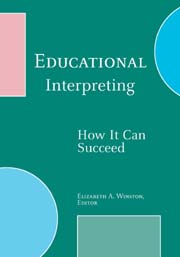How It Can Succeed
Elizabeth A. Winston, Editor
|
View the table of contents. View the list of contributors. Read an excerpt. Read reviews: The Midwest Book Review, The Sign Language Translator and Interpreter. |
$80.00s print edition $80.00 e-book |
This text has been replaced by Advances in Educational Interpreting.
From The Sign Language Translator and Interpreter, cont’d.
As a volume on educational interpreting, Winston’s text offers an unparalleled scholarly contribution to the field. It is a laudable compact collection of work and should be a staple text in the professional library of interpreters working in education settings, interpreter educators and researchers. In addition, it is a ‘must have’ item for institutions and schools providing interpreted education to deaf students. It would be of interest to community interpreters and students of interpreting also, with chapters on issues of relevance to the wider profession, including the ‘interpretability’ and visual accessibility of information, performance assessment, job analysis and expectations for occupational standards. This anthology offers a variety of perspectives to the reader, all pointing to the same flashing neon ‘use with caution’ sign that apparently should come with an interpreted education. The chapters by Winston herself Schick, Ramsey, and Schick and Williams are particularly noteworthy in the volume.
The volume, however, is North American-centric, with most contributors hailing from the US, and one Canadian author. Clarifying some specific terms, the age ranges specific to school settings and the various forms of legislation referred to by some authors would have been helpful to the broader international readership. Moreover, an international perspective on the issue of educational interpreting could have been of merit, as many other countries are grappling with the same issues.
The volume in many ways raises more questions than it answers. The sense of frustration regarding the state of affairs for deaf students in accessing an interpreted education is palpable throughout the book. A ‘call to arms’ is a theme threaded across all contributions, with demands for more research, higher standards and better quality. The by-line of the volume title “How It Can Succeed” is not well answered however — none of the contributions in the text present educational interpreting in a flattering light and perhaps missing is reference to any available studies demonstrating successful practice. Another gap in the volume is a final chapter from Winston, an expert in the field, to draw together the findings from the other contributors and to make explicit recommendations for the sector.
In conclusion, this is a ground breaking volume bringing together a collection of essays and research studies regarding the efficacy of educational interpreting. As Schick notes, “put simply, educating children with the use of an interpreter is an educational experiment” (p. 73) — one, as this volume adequately demonstrates time and time again, with very high stakes.
Elizabeth A. Winston is the director of the Teaching Interpreting Educators and Mentors (TIEM) Center in Loveland, CO, where she directs research into interpreter education practices, discourse analysis, assessment, and evaluation.
Print Edition: ISBN 978-1-56368-309-1, 7 x 10 casebound, 240 pages, 13 tables, 8 figures
$80.00s
E-Book: ISBN 978-1-56368-281-0
$80.00
